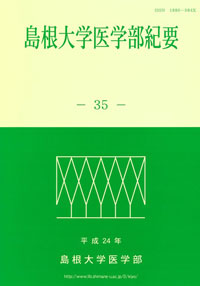島根大学医学部
ISSN:1880-084X

ダウンロード数 : ? 件
この文献の参照には次のURLをご利用ください : https://ir.lib.shimane-u.ac.jp/45527
島根大学医学部紀要 41
2019-03 発行
当科で行っている小児鼠径ヘルニアに対する腹腔鏡下経皮的腹膜外 ヘルニア閉鎖術(LPEC)の工夫
Scarless Laparoscopic Percutaneous Intraperitoneal Hernia Closure (LPEC) for Pediatric Inguinal Hernia
ファイル
内容記述(抄録等)
Laparoscopic percutaneous extraperitoneal closure (LPEC) is now widely utilized for pediatric inguinal hernia in many pediatric surgical facilities in Japan. One major advantage of LPEC is that it is possible to evaluate the presence or absence of contralateral occult inguinal hernia and simultaneous repair of bilateral hernia can be performed at one operation if it presents. We are concentrating on not leaving any scars after LPEC as much as possible, and we thus "puncture" the skin, not "cut", using a 2-mm scalpel for the insertion of forceps and Lapa-Her-ClosureTM needle. In addition, the forceps is directly inserted into the abdominal cavity without port placement. From January 2015 to December 2017, LPEC with this method was performed for 205 lesions in 133 female infants with inguinal hernia. The skin wounds faded and disappeared in all cases 2 months after surgery. The surgical site infections were not observed except for 3 cases with umbilical (camera ) port-site infection. The scarless LPEC is simple and useful for the treatment of pediatric inguinal hernia.
小児鼠径ヘルニアに対する腹腔鏡下経皮的腹膜外ヘルニア閉鎖術(laparoscopic percutaneous extraperitoneal closure:以下LPEC)は本邦の多くの小児外科専門施設で施行されて いる。LPECの利点の一つに手術の傷痕が小さいことが挙げられる。ただし、従来の鼠径部横切開による手術が、傷跡が残るものの下着で隠せる目立ちにくい位置であるのに対し、LPECでは鉗子挿入部位が下着で隠せない位置となるため、限りなく傷痕を残さない手術が求められる。当科では女児に限ってLPECを導入し、1)鉗子として最も細径かつ把持力の強い2mm剥離鉗子を使用する、2)不要な長い切開とならないように2mm幅のメスを使用する、3)鉗子の入れ替えが不要であるLPECの特徴を活かし、鉗子用ポートは使用せず、腹壁から鉗子を直接刺入する工夫を行っている。2015 年1月から2017 年12 月に、女児鼠径ヘルニア133 症例(205 病変)に本法を施行した。術後2か月で再診したときは創痕の視認ができなかった。当科におけるLPECの工夫は創痕が残らない、有用な手技と考えられた。
Other Article
